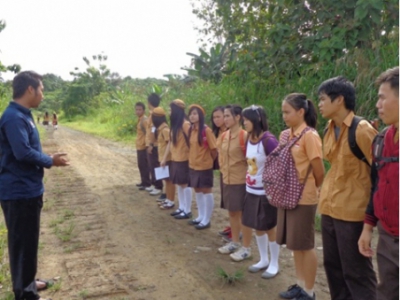Living among the Folks of Dayak Kenyah Tribe

Besides teaching, the teachers of SM3T program (The Scholars Teaching in the outermost, disadvantaged and frontier regions) have various activities outside of the classroom, such as growing plants in the field. Since they lived with the local people, they mingle with them by working together in planting rice, nuts or cords as experienced by Rahayudha (The alumnus of Geography Education Department of YSU) in Mahak Baru Village, Malinau regency, North Borneo.
“The students invited me to go into the woods and go fishing in the river.”, Rahayuda recalled. When walking in the forest with big and leafy trees, he was impressed with the purely natural scenery. “When I went into the woods for the very first time, we thought there were only wild animals inside,” he remembered his first creepy experience. “But finally we found a breathtaking green scenery near Boh river and there was no such a good feeling but peace to walk around there.”
Fishing in North Borneo, especially in Sungai Boh sub-district is also a heaven for catching big and small fish. The students and Rahayuda often catched fish in the river. He also often looked for firewoods for cooking.
When he came to Malinau from Java, he was confused on how to eat the local staple foods because the foods in Malinau are mostly different from those in Java. Malinau has rice, fish and chicken but its vegetables are new for his tounge. “I wondered about their taste,” Rahayuda expressed his enthusiasm. It was a memorable moment to eat rice produced from paddies grown in the mountain with chopped and stir-fried fern leaves. He also ate Tung Ubi (sweet potato leaves which are pounded and fried). He also found out that a plant uncommon to be eaten as vegetable in Java is eaten there. It was Sengga or Kolonjono leaves (Panicum Muticum) which was served as a delicious lalapan (similar to salad but no dressing). The favourite food of the local was the stir-fried Blusut or Kecombrang (Nicolaia speciosa) which gave a mint sensation in the throat.
Uniquely, the local also eat young pineapple as vegetables and the food was unexpextedly yummy. Rahayuda also told the reporter that the well-known traditional food of Kenyah people is Kapurung. It contains cale with sardine and starch and is served with the most spicy sausage as the dressing.
He was enthusiastic witnessing the preservation of tribal tradition in Mahak Baru Village, such as Beteq Amin ceremony (the traditional ceremony before building a house). In addition, the village has special dances such as couple dance, war dance, ajai dance, the same-movement dance, mass dance and tebengan lu’ung dance.
He also explained that the local spoke various languages: Bakung, Lepok Tau, Lepok Timei, Lepok Tukung and Umak Maut. They speak local languages as the indigenous language and the rule of manners. Besides, the languages were used for strenghtening the sense of a family, mutual symbiosis, unity and creating peace, enriching the Indonesian cultures as well as understanding the local culture itself.
He stated that the program (SM3T) is a good one to give opportunities for scholars to implement the knowledge and to sinergize it with the necessary of the local people in the outermost, disadvantaged, and frontier regions. “The mindset that education is not the first priority should be changed,” he said. He was encouraged to take a part to solve the problems in the region, saying,“The fact that students tend to be reluctant to study is because of the social environment effect ( the people paradigm about schools and the duty to work for family in the earlier ages.red) but the positive values of the local people is their tolerance among different religions so that they can live in peace.” (dedy/febi)

